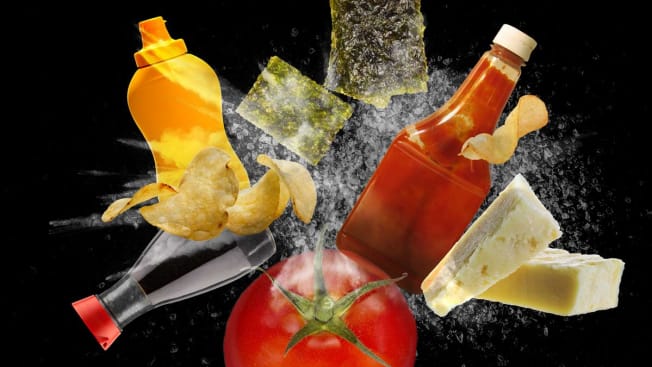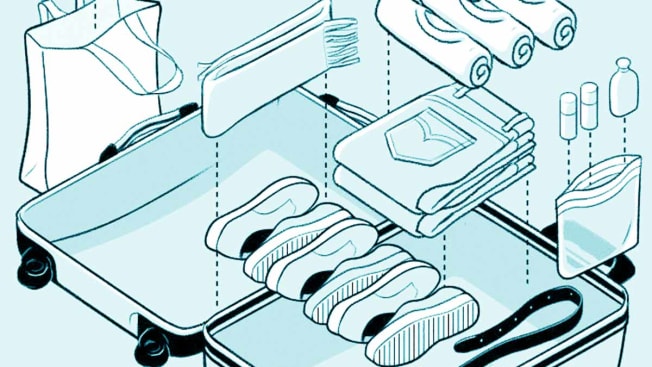
By Pang-Chieh Ho
This week, I’m examining whether my mom’s firmly held belief that MSG is harmful holds any water. Basically, like any good daughter, I’m looking to prove her wrong. Also in this issue: One of you wrote in asking what might be going wrong with your dishwasher, and we have our ideas.
THE BIG STORY
‘Some Food for Thought’My first impression of MSG was that it was tasty but its tastiness came with a price.
That impression was established early in my childhood when my family went out to restaurants. After the meal, my aunt sometimes complained about a tingling in her face. My mom would note her thirsty throat. My extended family, who liked to fight over everything, suddenly were in agreement about one thing: The food was delicious, but it likely had MSG.
My mom believed that MSG was harmful, though she was always vague about what was exactly bad about MSG. On a “don’t eat this” scale of 1 to 10, MSG was probably a 5 or a 6 to her. It wasn’t weapons-grade-level bad, but she found it to be a bonus when restaurants touted their food as MSG-free.
When we polled some of our social media users on whether they were concerned about MSG when they ate, 45 percent of Instagram followers said yes, while 55 percent said no, making people’s opinions on this issue somewhat split. But is MSG really bad for you? In other words, and this is probably the most high-stakes question of all time: Is my mom right?
Here’s what experts told me.
First, what is MSG, exactly?
MSG (aka monosodium glutamate) combines sodium with glutamate, an amino acid that is present in our bodies as well as in many foods. Glutamate—and MSG—adds umami to food. Often called the fifth taste, umami is a complex savory flavor, and it enhances salt perception.
Interestingly, MSG is found in several popular foods, including canned soups, instant noodles, cold cuts, soy sauce, and even chips and snacks. And while you can produce MSG commercially, MSG also naturally occurs in tomatoes, mushrooms, cheeses, and ingredients such as hydrolyzed vegetable protein, autolyzed yeast, hydrolyzed yeast, yeast extract, soy extracts, and protein isolate.
How did MSG get such a bad rap to begin with?
The perception that MSG is unhealthy or even unsafe began when an anecdotal report published in the New England Journal of Medicine in 1968 blamed symptoms of headaches and nausea potentially on the MSG consumed in Chinese restaurants.
The belief that MSG was unhealthy became widespread over the next few decades. Chinese food and restaurants were especially targeted, and the term “Chinese restaurant syndrome” was defined in an earlier entry of the Merriam-Webster dictionary as symptoms caused by “food and especially Chinese food heavily seasoned with monosodium glutamate.”
In recent years, the public perception of MSG has been challenged. In 2020, in response to an online campaign, Merriam-Webster updated its definition of “Chinese restaurant syndrome,” stating that the term has been criticized as “misleading and potentially offensive” and that “[r]esearch in the years since has failed to establish a clear link between those adverse reactions and the consumption of MSG.” Which brings us to the main question …
Is MSG safe?
There is no strong scientific evidence that suggests MSG is harmful, says Kantha Shelke, founder of Corvus Blue, a food science and research firm based in Chicago. And scientists have not been able to consistently trigger reactions in people who identify themselves as being sensitive to MSG, according to the Food and Drug Administration.
In 1995, MSG was concluded to be safe by the Federation of American Societies for Experimental Biology. The organization’s report, which was commissioned by the FDA, did state, however, that symptoms were identified in some sensitive people who consumed 3,000 mg or more of MSG in one sitting without food.
However, given that a typical serving of a food with added MSG usually contains less than 500 mg, it’s highly unlikely that people would be consuming more than 3,000 mg of MSG without food in one sitting, the FDA says. And if you cut back on eating processed, packaged, and fast foods, you’re likely to consume less MSG.
More recently, a 2017 report from the European Food Safety Authority said that symptoms from MSG are rarely seen at intake levels below 3,000 mg and that an acceptable daily intake is 14.5 mg per pound of body weight. Which, for example, if you weigh 150 pounds means 2,175 mg.
It’s worth noting, though, that MSG is a source of sodium. While MSG contains less sodium than table salt, you might still be consuming a lot of sodium if you eat too much MSG. MSG contains 480 mg sodium per teaspoon, and the daily recommendation for sodium is less than 2,300 mg per day.
Here’s the bottom line: No, MSG isn’t really bad for you and moms aren’t always right, but if you are worried, you can check the labels and eat fewer foods with flavoring ingredients that may contain MSG. The FDA requires that foods containing added MSG list it as monosodium glutamate on the ingredients list.
If an ingredient that naturally contains MSG is in a food, the FDA doesn’t require that it says it contains MSG on the label. However, foods with such ingredients can’t have claims such as “No MSG” or “No added MSG” on their packaging.
QUIZ
We’re experiencing one of the largest outbreaks of monkeypox outside of its endemic countries. Which statement about monkeypox is true?
A. Monkeypox comes from monkeys.
B. It’s a new disease that scientists only recently identified.
C. One of the most common symptoms is a rash.
D. There are no vaccines against monkeypox.
THE GOOD STUFF
There’s something unique about the rear window of this truck.
ASK AN EXPERT
Reader’s question: After my dishwasher cycle is complete, the dishes are still wet, and they used to be completely dry. Any suggestions on how to fix it, or do I need to just buy a new dishwasher?
Our answer: Without knowing the brand of the dishwasher, here are some general ideas on what might be going on. It could be the heating element of your unit is faulty, or the electronic control (if you have one) may have a bad button and it’s not activating the heater, says Larry Ciufo, who has tested dishwashers for CR for 15 years and has fixed a few dishwashers himself.
If your dishwasher does not have a heating element, the water heater that raises the water temperature to help with the drying is likely not working. The best thing to do is to call a repair person; they should be able to easily fix any of these issues.
If you have a question you want to ask an expert, email me. I’m all ears!
WEINER TAKES ALL
What makes a perfect hot dog for you? Is it flavor? Juiciness? Texture? We tasted several supermarket hot dogs for these factors and more to find out which is the best.
The clear winner is Nathan’s Famous Skinless Beef Franks. They were described by CR food writer Paul Hope as “the Goldilocks of hot dogs: crisp skin, subtle spice, uniform texture, and juicy.”
On the other side of the spectrum, we have a hot dog that elicited an “It’s not disgusting. It’s just disappointing” review from CR reporter Angela Lashbrook. If you’re curious about which hot dog is the definition of “Eh, this is whatever,” you can check out our hot dog evaluation here.
And if you’re more into vegan hot dogs, don’t worry, we’ve also got you covered with our evaluation of the best vegan hot dogs.
TIP OF THE WEEK

Illustration: Señor Salme
When I’m going on a trip, I like to travel light. But it’s funny how often our sense of realism can just fly out of the window when we’re packing for a trip, and we end up overpacking.
If you want to be more efficient about packing and avoid overloading your suitcase, here are some great tips (and you can read the full list of our advice here).
Remember, you don’t need a new outfit every day. Instead, take items that you can mix and match into different outfits, following a 3-to-1 ratio (three tops for every bottom).
Roll up soft clothes that don’t wrinkle easily. It’ll save space in your suitcase.
Don’t leave your shoes empty. You can put small items of clothing or accessories into sandwich bags and stuff them into shoes.
What are the hacks you use to make everything fit in your suitcase? Drop me a note.
IN CELEBRATION OF PRIDE MONTH

Graphic: Consumer Reports
We should remember computer science pioneer Alan Turing, who was behind the breaking of the Nazi Enigma code during World War II. Turing was convicted of “gross indecency” in 1952 during a time when homosexuality was still a crime in Great Britain. He was only granted a posthumous pardon by Queen Elizabeth II almost 60 years after his death. To learn more about Turing, read here.
FEATURES OF THE WEEK
What Does the Overturn of Roe v. Wade Mean for You?
Here are our answers to some pressing questions, such as which states will abortion be illegal immediately or soon.
🥬 Which Food to Buy Organic (and How to Spend Less When You Do)
Today I learned that for fish and shellfish raised in the U.S., organic labels are pretty much meaningless.
💸 How to Save Money As Consumer Prices Keep Rising
Time for me to argue haggle with Spectrum to lower my internet costs.
🚗 The Best Cars of 2022 That Nobody Bought Last Year (Available to CR members)
Hey, sedans deserve our love, too.
THE SHORT ANSWER
There’s a tampon shortage going on right now. Should you make your own tampons? Uh, no.
QUIZ ANSWER
The answer is C. One of the most common symptoms of monkeypox is a rash that can start on the face and then spread to other parts of the body—though it can appear in other locations first, too.
Some other facts: While monkeypox was first identified in monkeys, experts believe that the virus actually likely came from rodents. And no, it’s not a new disease—we’ve known about it for decades.
One piece of the good news is that there are vaccines for monkeypox. Because monkeypox is closely related to smallpox, the two vaccines that are approved against smallpox can be used against the disease.
Have more questions about monkeypox? We’ve answered common questions about the disease here.
Consumer Reports is an independent, nonprofit organization that works side by side with consumers to create a fairer, safer, and healthier world. CR does not endorse products or services, and does not accept advertising. Copyright © 2022, Consumer Reports, Inc.
Did you find this post inspiring? Share on Pinterest by pinning this article!
